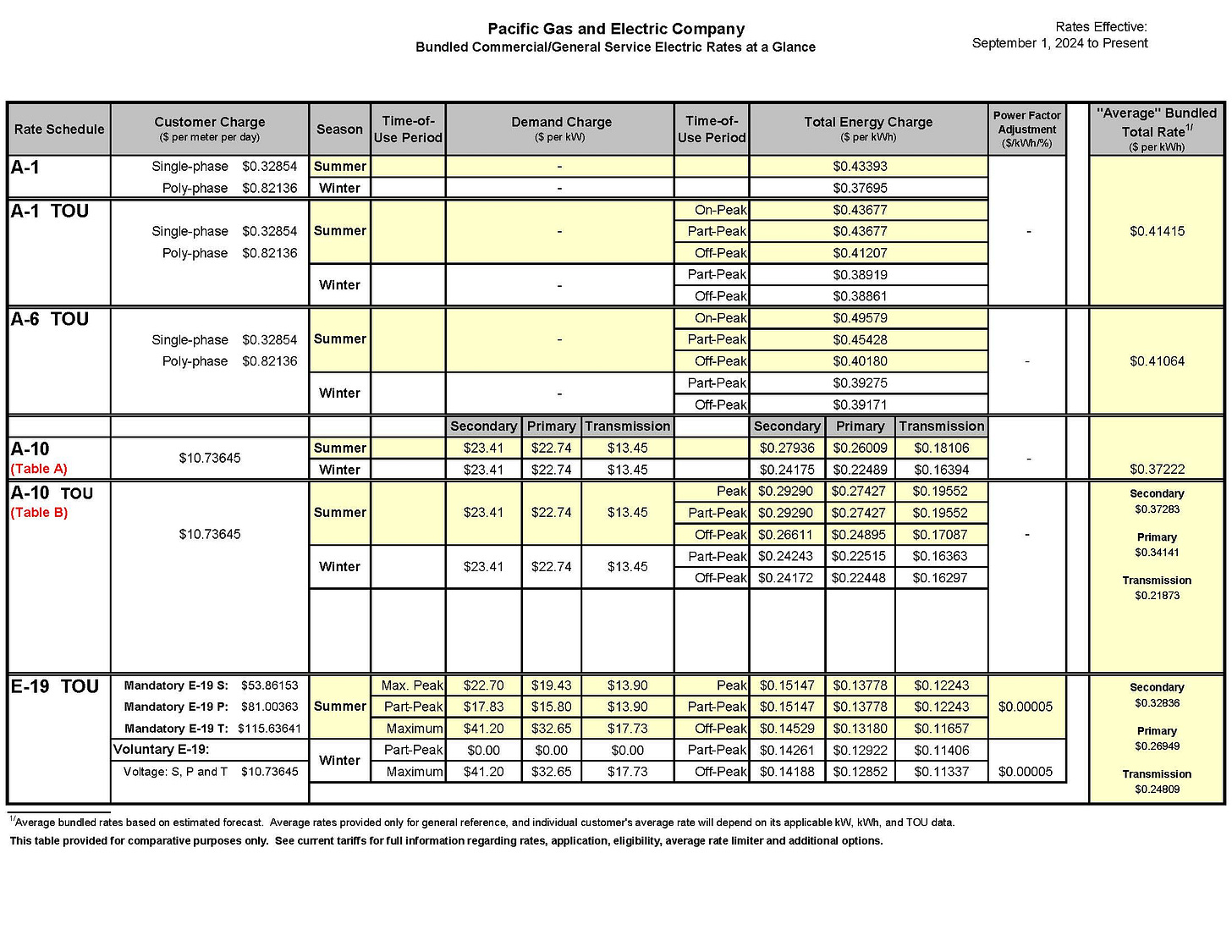After my last Substack, I received a request to explain demand charges So here is my attempt, let’s talk about Utility demand charges, how they are calculated, why they are used, and the impact they can have on a customer’s utility bill.
First, just because you are not paying a monthly demand charge, you are not entirely escaping it. For residential and small business customers, those charges are included in your kwh rate, they are not broken out, but a small fee is there. A demand charge is a capacity charge from the utility. It is intended to reflect cost of the wire, the transformers, etc. that are required to serve a load of your size. The demand charge reflects the highest usage in a timed period each monthly billing cycle. Those time periods are usually 15 or 30 minutes, depending on the utility. So, if you turn on something really big and run it for twenty minutes with a 15 minute demand period, and that is the only time you use it. You will set your demand charge for the entire month based on that one twenty-minute run. It may seem unfair, but the utility had to have the capacity in their system to serve that load for twenty minutes, and they want you to help pay for it. Depending on the utility, somewhere around 100 kw of demand is where a demand rate begins to be required. However, you can request one if you want. There are even residential demand rates available from some utilities.
So how are the calculated? The formula is kwh consumed in the 60/period x kwh. Let’s say I have a 15-minute demand period and during that 15 minutes I use 42kwh. 60/15x42= 168 kw demand. This calculation takes place every 15 minutes for the entire billing period, and the demand charge is the highest 15-minute period recorded.
The old mechanical meters had a gear mechanism that drove a set of demand registers. As the disk rotated it would drive the hands of the registers, at the end of the timed demand period, a clutch would release and reset the gears to zero. The hands were held in place at the highest value recorded until reset by the meter reader. The new electronic meters do this all digitally.
Now, an example of how demand periods work. My demand meter serves a pump that draws 300 kw. The pump only runs to pump out a basin when it fills. Last hour the pump ran once for 7.5 minutes. In a 15-minute demand period I set a demand value of 150 kw. However, in a 30 minute demand period I set a demand of 75 kw. Of the three utilities I researched, PG&E, and Xcel-Minnesota used a 15-minute demand period. AEP-Ohio used a 30-minute demand period.
So, what does this do to my bill? The demand charge itself is pretty expensive, but since they break it out from your kwh rate you pay less per kwh than a non-demand charge rate. The demand is charged as a kw-month, or you pay for the kw demand for the whole billing period. Where it gets very expensive is if you have a high demand, but a low kwh per month usage. For instance, if I have a 200 kw-month demand charge, I will want to be using at least 72,000 kwh in a 30-day billing period to make that demand charge pencil out. If I am using less energy in kwh, then I may want to do something to limit my demand. Here are the charges for a PG&E rate schedule. As they charge for demand, you can see the kwh rate goes down.
You can see an A-10 summer demand of 200 kw at the user voltage (secondary) would cost $4682.00 just for the demand charge. If I only used that demand once in a month, that’s a pretty damn expensive 15 minutes.
There is such a thing as a reactive demand charge, but let’s leave that deep water for another time.






You are correct in stating that the demand charge is collected in residential billing. Typically, there are multiple rate blocks charging a different price per kilowatt hour in each block. The demand charge is collected in the first-rate block, which is the estimated minimum kilowatt-hour usage for that class of service—in this example, residential. If you look at the utility rate schedule, the first block of usage is substantially higher than the other blocks—this is for the collection of the demand charge. As a result, when a utility goes to demand and energy rates on residential customers (automated remote meter reading allows them to do this), the "average" customer doesn't see much of a change in their electric bill - because they are already paying the demand charge in the first-rate block. Those who complain are the low-energy users like stock pumps or summer vacation homes heated by gas in the winter.
" Let’s say I have a 15-minute demand period and during that 15 minutes I use 42kwh. 60/15x42= 68 kw demand"
That's 168KW not 68KW.